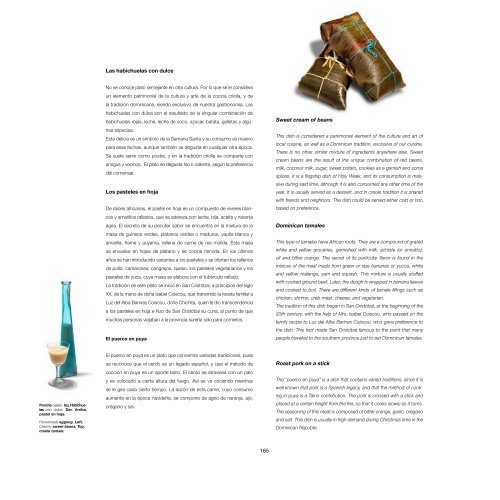Sabores-Ancestrales-Digital-1
You also want an ePaper? Increase the reach of your titles
YUMPU automatically turns print PDFs into web optimized ePapers that Google loves.
Las habichuelas con dulce<br />
No se conoce plato semejante en otra cultura. Por lo que se le considera<br />
un elemento patrimonial de la cultura y arte de la cocina criolla, y de<br />
la tradición dominicana, siendo exclusivo de nuestra gastronomía. Las<br />
habichuelas con dulce son el resultado de la singular combinación de<br />
habichuelas rojas, leche, leche de coco, azúcar, batata, galletas y algunas<br />
especias.<br />
Esta delicia es un símbolo de la Semana Santa y su consumo es masivo<br />
para esas fechas, aunque también se degusta en cualquier otra época.<br />
Se suele servir como postre, y en la tradición criolla se comparte con<br />
amigos y vecinos. El plato se degusta frío o caliente, según la preferencia<br />
del comensal.<br />
Los pasteles en hoja<br />
De raíces africanas, el pastel en hoja es un compuesto de víveres blancos<br />
y amarillos rallados, que se adereza con leche, bija, aceite y naranja<br />
agria. El secreto de su peculiar sabor se encuentra en la mixtura de la<br />
masa de guineos verdes, plátanos verdes o maduros, yautía blanca y<br />
amarilla, ñame y auyama, rellena de carne de res molida. Esta masa<br />
se envuelve en hojas de plátano y se cocina hervida. En los últimos<br />
años se han introducido variantes a los pasteles y se ofertan los rellenos<br />
de pollo, camarones, cangrejos, queso, los pasteles vegetarianos y los<br />
pasteles de yuca, cuya masa se elabora con el tubérculo rallado.<br />
La tradición de este plato se inició en San Cristóbal, a principios del siglo<br />
XX, de la mano de doña Isabel Coiscou, que transmitió la receta familiar a<br />
Luz del Alba Barinas Coiscou, doña Chichita, quien le dio transcendencia<br />
a los pasteles en hoja e hizo de San Cristóbal su cuna, al punto de que<br />
muchas personas viajaban a la provincia sureña solo para comerlos.<br />
El puerco en puya<br />
Sweet cream of beans<br />
This dish is considered a patrimonial element of the culture and art of<br />
local cuisine, as well as a Dominican tradition, exclusive of our cuisine.<br />
There is no other similar mixture of ingredients anywhere else. Sweet<br />
cream beans are the result of the unique combination of red beans,<br />
milk, coconut milk, sugar, sweet potato, cookies as a garnish and some<br />
spices. It is a flagship dish of Holy Week, and its consumption is massive<br />
during said time, although it is also consumed any other time of the<br />
year. It is usually served as a dessert, and in creole tradition it is shared<br />
with friends and neighbors. The dish could be served either cold or hot,<br />
based on preference.<br />
Dominican tamales<br />
This type of tamales have African roots. They are a compound of grated<br />
white and yellow groceries, garnished with milk, achiote (or annatto),<br />
oil and bitter orange. The secret of its particular flavor is found in the<br />
mixture of the meal made from green or ripe bananas or yucca, white<br />
and yellow malanga, yam and squash. This mixture is usually stuffed<br />
with cooked ground beef. Later, the dough is wrapped in banana leaves<br />
and cooked to boil. There are different kinds of tamale fillings such as<br />
chicken, shrimp, crab meat, cheese, and vegetarian.<br />
The tradition of this dish began in San Cristóbal, at the beginning of the<br />
20th century, with the help of Mrs. Isabel Coiscou, who passed on the<br />
family recipe to Luz del Alba Barinas Coiscou, who gave preference to<br />
the dish. This fact made San Cristóbal famous to the point that many<br />
people traveled to the southern province just to eat Dominican tamales.<br />
Ponche casero. Izq. Habichuelas<br />
con dulce. Der. Arriba,<br />
pastel en hoja.<br />
Homemade eggnog. Left,<br />
Creamy sweet beans. Top,<br />
creole tamale.<br />
El puerco en puya es un plato que concentra variadas tradiciones, pues<br />
se reconoce que el cerdo es un legado español, y que el método de<br />
cocción en puya es un aporte taíno. El cerdo se atraviesa con un palo<br />
y es colocado a cierta altura del fuego. Así se va cociendo mientras<br />
se le gira cada cierto tiempo. La sazón de esta carne, cuyo consumo<br />
aumenta en la época navideña, se compone de agrio de naranja, ajo,<br />
orégano y sal.<br />
Roast pork on a stick<br />
The “puerco en puya” is a dish that contains varied traditions, since it is<br />
well known that pork is a Spanish legacy, and that the method of cooking<br />
in puya is a Taíno contribution. The pork is crossed with a stick and<br />
placed at a certain height from the fire, so that it cooks slowly as it turns.<br />
The seasoning of this meat is composed of bitter orange, garlic, oregano<br />
and salt. This dish is usually in high demand during Christmas time in the<br />
Dominican Republic.<br />
165


